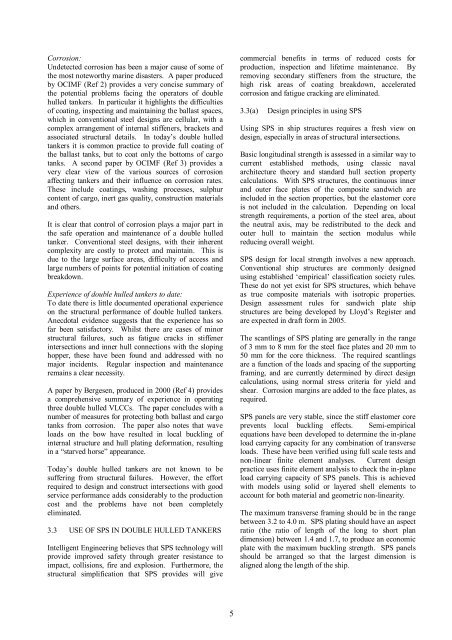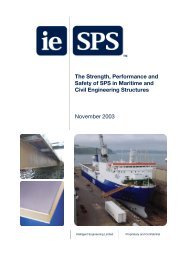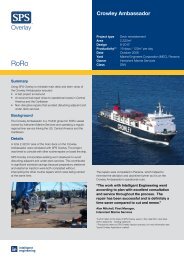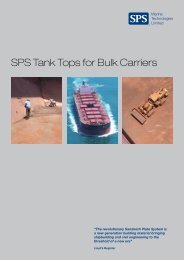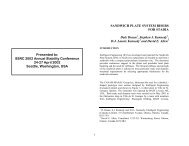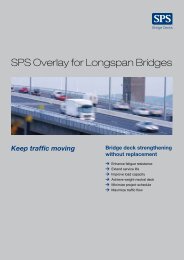The Performance, Safety and Production Benefits of SPS Structures ...
The Performance, Safety and Production Benefits of SPS Structures ...
The Performance, Safety and Production Benefits of SPS Structures ...
You also want an ePaper? Increase the reach of your titles
YUMPU automatically turns print PDFs into web optimized ePapers that Google loves.
Corrosion:Undetected corrosion has been a major cause <strong>of</strong> some <strong>of</strong>the most noteworthy marine disasters. A paper producedby OCIMF (Ref 2) provides a very concise summary <strong>of</strong>the potential problems facing the operators <strong>of</strong> doublehulled tankers. In particular it highlights the difficulties<strong>of</strong> coating, inspecting <strong>and</strong> maintaining the ballast spaces,which in conventional steel designs are cellular, with acomplex arrangement <strong>of</strong> internal stiffeners, brackets <strong>and</strong>associated structural details. In today’s double hulledtankers it is common practice to provide full coating <strong>of</strong>the ballast tanks, but to coat only the bottoms <strong>of</strong> cargotanks. A second paper by OCIMF (Ref 3) provides avery clear view <strong>of</strong> the various sources <strong>of</strong> corrosionaffecting tankers <strong>and</strong> their influence on corrosion rates.<strong>The</strong>se include coatings, washing processes, sulphurcontent <strong>of</strong> cargo, inert gas quality, construction materials<strong>and</strong> others.It is clear that control <strong>of</strong> corrosion plays a major part inthe safe operation <strong>and</strong> maintenance <strong>of</strong> a double hulledtanker. Conventional steel designs, with their inherentcomplexity are costly to protect <strong>and</strong> maintain. This isdue to the large surface areas, difficulty <strong>of</strong> access <strong>and</strong>large numbers <strong>of</strong> points for potential initiation <strong>of</strong> coatingbreakdown.Experience <strong>of</strong> double hulled tankers to date:To date there is little documented operational experienceon the structural performance <strong>of</strong> double hulled tankers.Anecdotal evidence suggests that the experience has s<strong>of</strong>ar been satisfactory. Whilst there are cases <strong>of</strong> minorstructural failures, such as fatigue cracks in stiffenerintersections <strong>and</strong> inner hull connections with the slopinghopper, these have been found <strong>and</strong> addressed with nomajor incidents. Regular inspection <strong>and</strong> maintenanceremains a clear necessity.A paper by Bergesen, produced in 2000 (Ref 4) providesa comprehensive summary <strong>of</strong> experience in operatingthree double hulled VLCCs. <strong>The</strong> paper concludes with anumber <strong>of</strong> measures for protecting both ballast <strong>and</strong> cargotanks from corrosion. <strong>The</strong> paper also notes that waveloads on the bow have resulted in local buckling <strong>of</strong>internal structure <strong>and</strong> hull plating deformation, resultingin a “starved horse” appearance.Today’s double hulled tankers are not known to besuffering from structural failures. However, the effortrequired to design <strong>and</strong> construct intersections with goodservice performance adds considerably to the productioncost <strong>and</strong> the problems have not been completelyeliminated.3.3 USE OF <strong>SPS</strong> IN DOUBLE HULLED TANKERSIntelligent Engineering believes that <strong>SPS</strong> technology willprovide improved safety through greater resistance toimpact, collisions, fire <strong>and</strong> explosion. Furthermore, thestructural simplification that <strong>SPS</strong> provides will givecommercial benefits in terms <strong>of</strong> reduced costs forproduction, inspection <strong>and</strong> lifetime maintenance. Byremoving secondary stiffeners from the structure, thehigh risk areas <strong>of</strong> coating breakdown, acceleratedcorrosion <strong>and</strong> fatigue cracking are eliminated.3.3(a)Design principles in using <strong>SPS</strong>Using <strong>SPS</strong> in ship structures requires a fresh view ondesign, especially in areas <strong>of</strong> structural intersections.Basic longitudinal strength is assessed in a similar way tocurrent established methods, using classic navalarchitecture theory <strong>and</strong> st<strong>and</strong>ard hull section propertycalculations. With <strong>SPS</strong> structures, the continuous inner<strong>and</strong> outer face plates <strong>of</strong> the composite s<strong>and</strong>wich areincluded in the section properties, but the elastomer coreis not included in the calculation. Depending on localstrength requirements, a portion <strong>of</strong> the steel area, aboutthe neutral axis, may be redistributed to the deck <strong>and</strong>outer hull to maintain the section modulus whilereducing overall weight.<strong>SPS</strong> design for local strength involves a new approach.Conventional ship structures are commonly designedusing established ‘empirical’ classification society rules.<strong>The</strong>se do not yet exist for <strong>SPS</strong> structures, which behaveas true composite materials with isotropic properties.Design assessment rules for s<strong>and</strong>wich plate shipstructures are being developed by Lloyd’s Register <strong>and</strong>are expected in draft form in 2005.<strong>The</strong> scantlings <strong>of</strong> <strong>SPS</strong> plating are generally in the range<strong>of</strong> 3 mm to 8 mm for the steel face plates <strong>and</strong> 20 mm to50 mm for the core thickness. <strong>The</strong> required scantlingsare a function <strong>of</strong> the loads <strong>and</strong> spacing <strong>of</strong> the supportingframing, <strong>and</strong> are currently determined by direct designcalculations, using normal stress criteria for yield <strong>and</strong>shear. Corrosion margins are added to the face plates, asrequired.<strong>SPS</strong> panels are very stable, since the stiff elastomer coreprevents local buckling effects. Semi-empiricalequations have been developed to determine the in-planeload carrying capacity for any combination <strong>of</strong> transverseloads. <strong>The</strong>se have been verified using full scale tests <strong>and</strong>non-linear finite element analyses. Current designpractice uses finite element analysis to check the in-planeload carrying capacity <strong>of</strong> <strong>SPS</strong> panels. This is achievedwith models using solid or layered shell elements toaccount for both material <strong>and</strong> geometric non-linearity.<strong>The</strong> maximum transverse framing should be in the rangebetween 3.2 to 4.0 m. <strong>SPS</strong> plating should have an aspectratio (the ratio <strong>of</strong> length <strong>of</strong> the long to short pl<strong>and</strong>imension) between 1.4 <strong>and</strong> 1.7, to produce an economicplate with the maximum buckling strength. <strong>SPS</strong> panelsshould be arranged so that the largest dimension isaligned along the length <strong>of</strong> the ship.5


